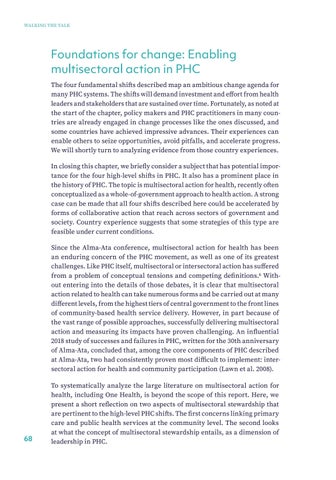WALKING THE TALK
Foundations for change: Enabling multisectoral action in PHC The four fundamental shifts described map an ambitious change agenda for many PHC systems. The shifts will demand investment and effort from health leaders and stakeholders that are sustained over time. Fortunately, as noted at the start of the chapter, policy makers and PHC practitioners in many countries are already engaged in change processes like the ones discussed, and some countries have achieved impressive advances. Their experiences can enable others to seize opportunities, avoid pitfalls, and accelerate progress. We will shortly turn to analyzing evidence from those country experiences. In closing this chapter, we briefly consider a subject that has potential importance for the four high-level shifts in PHC. It also has a prominent place in the history of PHC. The topic is multisectoral action for health, recently often conceptualized as a whole-of-government approach to health action. A strong case can be made that all four shifts described here could be accelerated by forms of collaborative action that reach across sectors of government and society. Country experience suggests that some strategies of this type are feasible under current conditions. Since the Alma-Ata conference, multisectoral action for health has been an enduring concern of the PHC movement, as well as one of its greatest challenges. Like PHC itself, multisectoral or intersectoral action has suffered from a problem of conceptual tensions and competing definitions.6 Without entering into the details of those debates, it is clear that multisectoral action related to health can take numerous forms and be carried out at many different levels, from the highest tiers of central government to the front lines of community-based health service delivery. However, in part because of the vast range of possible approaches, successfully delivering multisectoral action and measuring its impacts have proven challenging. An influential 2018 study of successes and failures in PHC, written for the 30th anniversary of Alma-Ata, concluded that, among the core components of PHC described at Alma-Ata, two had consistently proven most difficult to implement: intersectoral action for health and community participation (Lawn et al. 2008).
68
To systematically analyze the large literature on multisectoral action for health, including One Health, is beyond the scope of this report. Here, we present a short reflection on two aspects of multisectoral stewardship that are pertinent to the high-level PHC shifts. The first concerns linking primary care and public health services at the community level. The second looks at what the concept of multisectoral stewardship entails, as a dimension of leadership in PHC.


